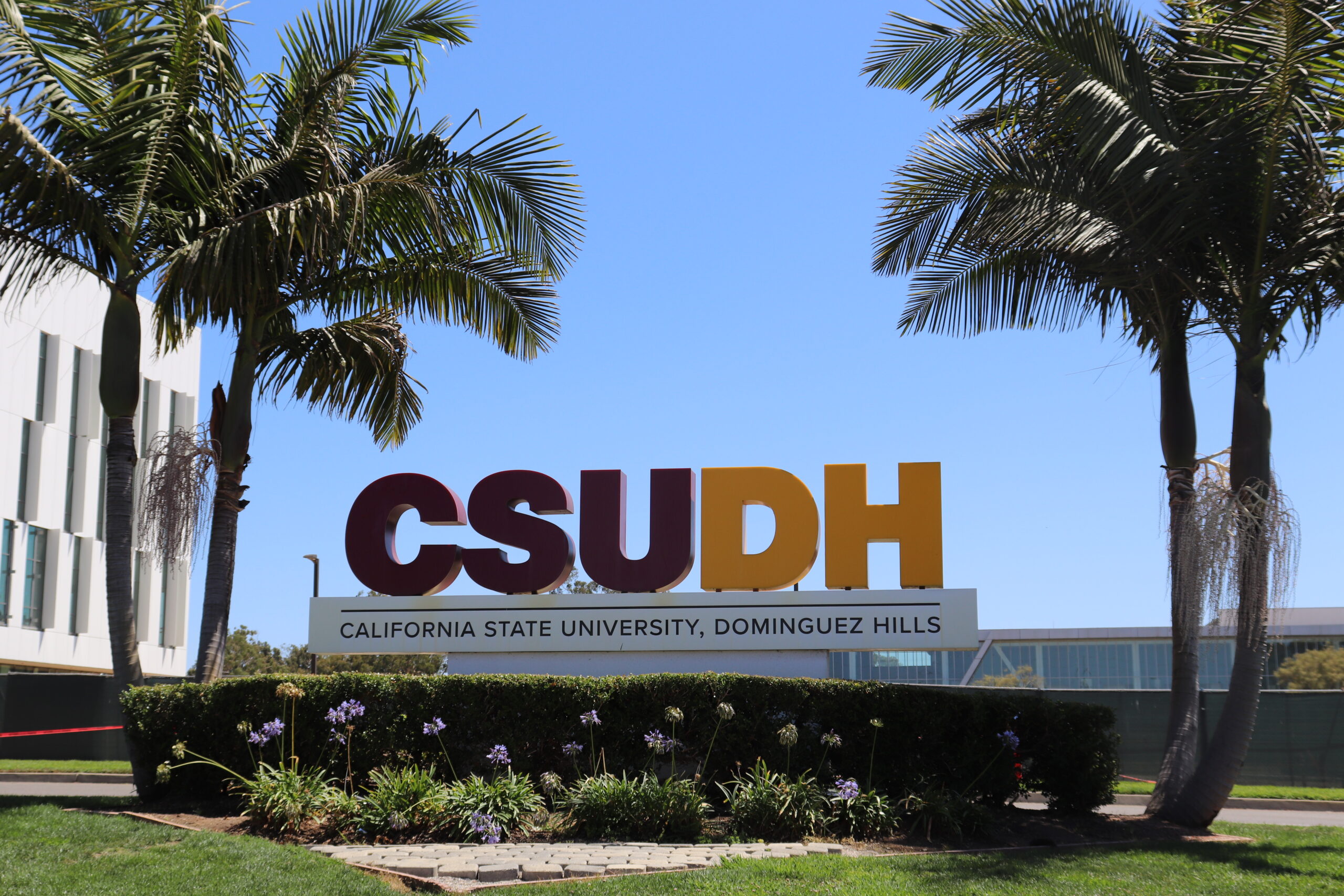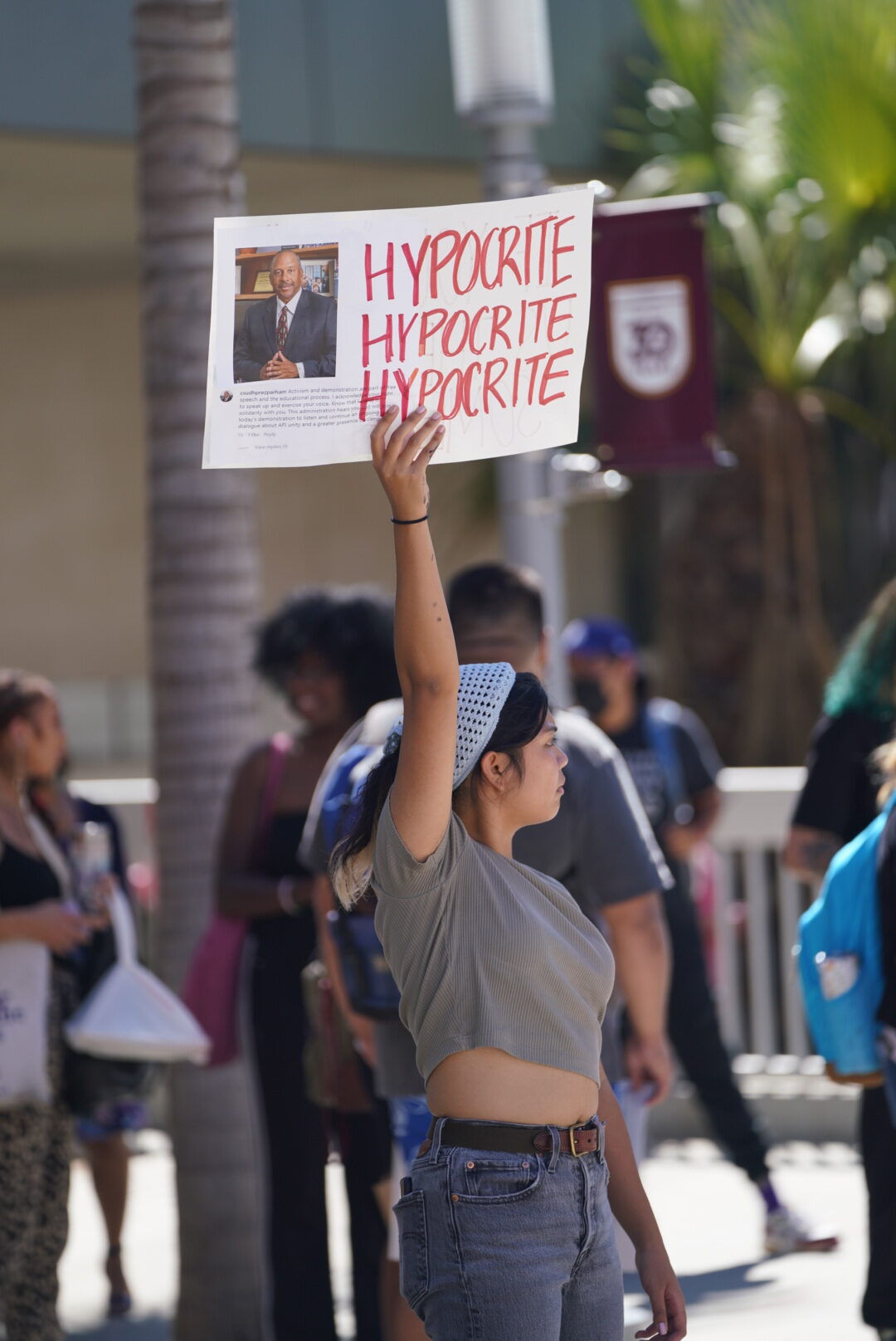CSUDH is among the 23 CSU campuses that must decide on its own how to cut costs as CSU funds are reduced b $299 million. Photo by Iracema Navarro.
By Brenda Fernanda Verano, News Editor
Additional reporting by Carina Noyola, Staff Reporter
Of the approximately 400 faculty members and staff eligible to take a retirement program offered by the university in hopes of staving off layoffs, only nine signed up before the Oct. 2 deadline.
The Early Exit Program (EEP) is one of the strategies the university is implementing to help offset a projected deficit of nearly $4.6 million to its base, or permanent, budget.
That deficit is a result of COVID-19-related impacts on the state budget, which faces a $54 billion deficit in the 2020-21 fiscal year, which began July 1.
California Gov. Gavin Newsom signed a revised budget on June 30 that reduced CSU funds by $299 million. Those cuts were divided up among the 23 CSU campuses, and CSUDHs’ portion was approximately $7.5 million.
But according to a presentation part of a campus budget update webinar in August, an additional $2.4 million in mandatory costs spikes that figure to nearly $10 million. Through a series of cost-cutting measures, including stripping the university’s travel budget and identifying vacant positions that will not be filled, the university saved about $5.3 million, but that still leaves a nearly $4.6 million hole.
Since employee salaries and benefits account for about 75 percent of campus expenditures, that is where a substantial part of that money will come from.
“When we’re talking about finding those budget cuts, especially to the turn of $4.5 million, we can’t just be looking at operating expenses or sort of trimming around the margins,” Katie Robinson the CSUDH budget director said in an EEP information session held over Zoom Sept. 30. “We really need to start discussing [employee] compensation.”
The EEP program, which was announced Sept. 1 and closed enrollment on Oct. 2, offered a three-month severance package to employees. To be eligible, employees must have 10 years accrued in CalPers, the state’s public employees retirement system.
The goal of the program was to entice enough eligible faculty and staff to join in hopes to “mitigate layoffs as much as possible by…incentivizing those employees who feel it would be an appropriate move for them,” Porter said Aug. 30.
If no further action were taken to reduce the $4.5 deficit, the university would incur about $375,000 a month in non-funded expenses, she added.
“Bottom line for us is if we don’t get broad participation within [EEP]…we will definitely go to a layoff option,” Deborah Wallace, the vice president of Administration and Finance said in the Aug. 30 session.
The nine employees out of the approximately 400 eligible employees was a “number lower than anticipated,” according to an email sent to the Bulletin by Karine Shirninian, associate vice president of Human Resources Management.
The low number may have been affected by the amount of the severance package. Some CSU’s were offering a six-month severance package, Porter said Aug. 30, but CSUDH is underfunded by the CSU due to the system’s funding mechanism, which allocates money per full-time equivalent students. What that means, she said, is that schools with more part-time students don’t get as much money from the CSU.
She explained that CSUDH receives about $9,000 per FTE student, while Humboldt State receives $10,000 and the Channel Islands campus receives $11,000.
That puts those campuses in a different budget position than CSUDH, Porter said, in that they “don’t have to use every single dollar of every year, so they can build up their reserves in anticipation of economic downfalls.”
CSUDH doesn’t have that luxury, and because much of its $5 million in reserves is earmarked for other projects it is unable to use all those reserves to cover its deficit, or to offer a more attractive severance package.
Daryl Evans is a business adviser and retention analyst in the College of Business, and chief steward of the Academic Professionals of California (APC), one of seven employee unions on campus, which represents academic and financial aid advisers, and admissions evaluators. He said the approximately 150 APC members on this campus aren’t necessarily “fearful” of any impending layoffs.
“Enrollment continues to be strong and when you are hands-on with the students [we offer] that is a necessary service,” he said.
Evans said last week that he wouldn’t recommend the EEP to anyone other than employees who were on the verge of retirement due to the three-month only severance package.
“Some of the schools were talking a six-month severance package and a minimum of $36,000,” Evans said. “I don’t like [CSUDH’s] agreement at all but [the university] is not in a position to offer a really good incentive for people to leave. All that money has to come from somewhere, a bank account more of less, and we don’t just have it.”
Each of the 23 CSU campuses must decide on its own how to cut costs. And those colleges with more reserves can dip into them to offset their deficits.
CSUDH’s $5 million reserve, while higher than some CSUs, such as Sonoma State’s reported $2.2 million, is dwarfed by schools like San Francisco State, which is spending nearly $8 million of its reserves to offset its deficit, roughly 35 percent of its total reserves.
Even with that expenditure, 131 of San Francisco State’s staff employees were notified last month that they will be laid off Nov. 9.
Vice President Wallace said in last week’s informational session that if layoffs do come to CSUDH, first employees would be laid off for lack of work, and then lack of funds.
The APC’s contract calls for less senior employees to be laid off first. Evans said that while he cannot speak for any of the other unions on campus, he “suspects” their contracts are similar.
According to Vice Provost, Ken O’Donnell, the Division of Academic Affairs is working to minimize the potential impact that budget cuts may have on class sizes, acceptance rates, and the amount of classes that will be available to students.
“The provost has directed deans to prioritize class availability for students, even when that means making deeper cuts in other areas, he said.
Additionally, O’Donnell said, cuts in staff will not affect admissions.
“We will continue to accept all eligible students who apply for admission,” he said.



